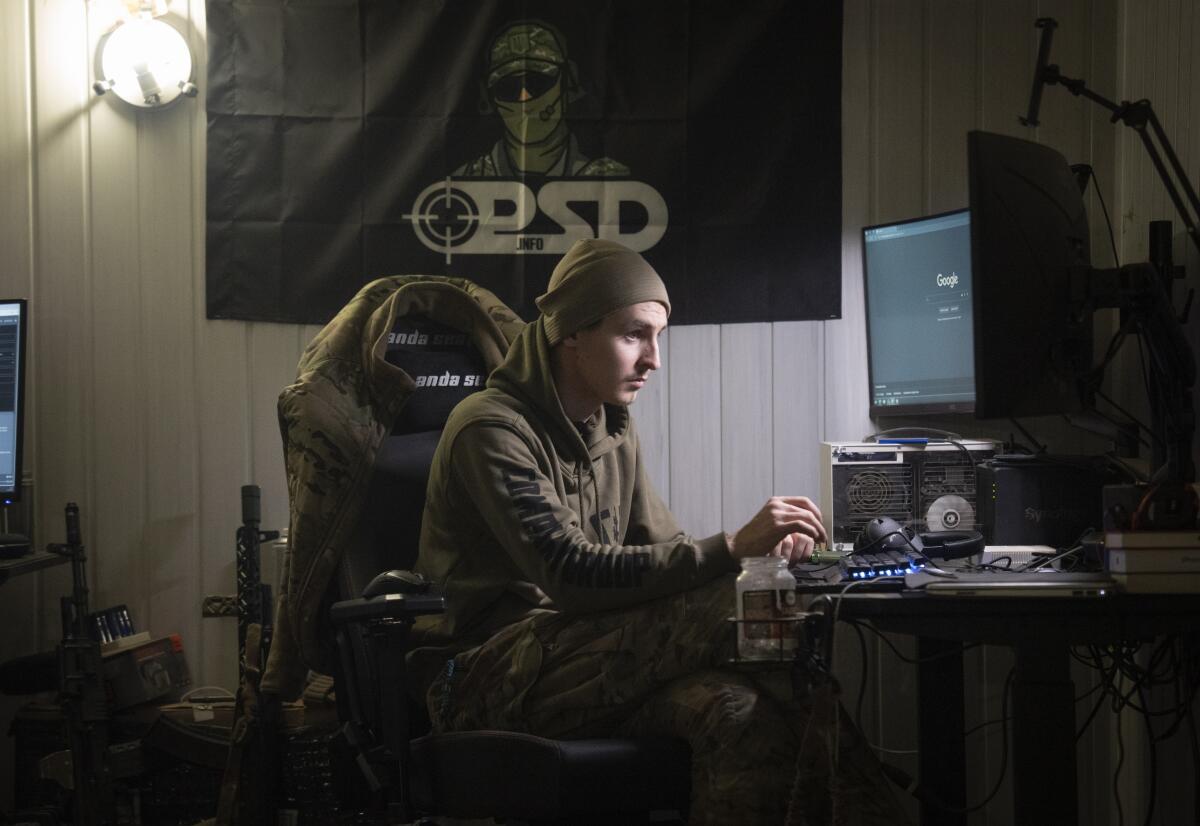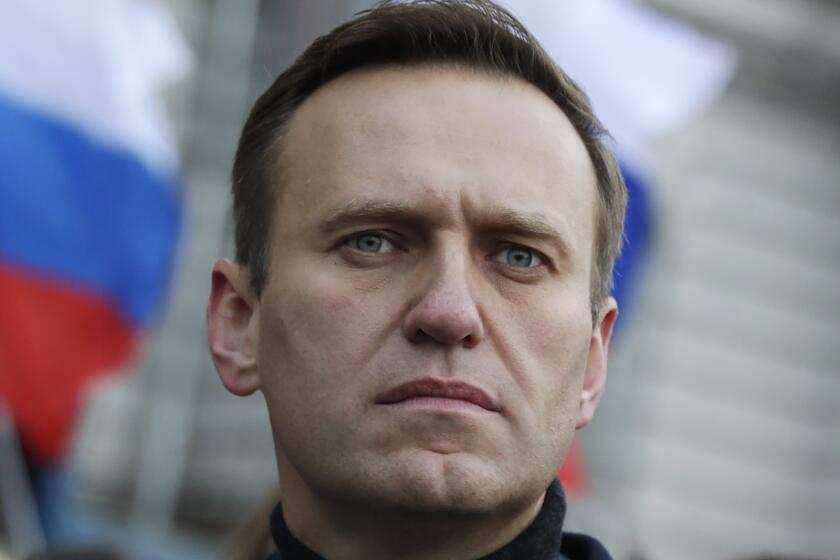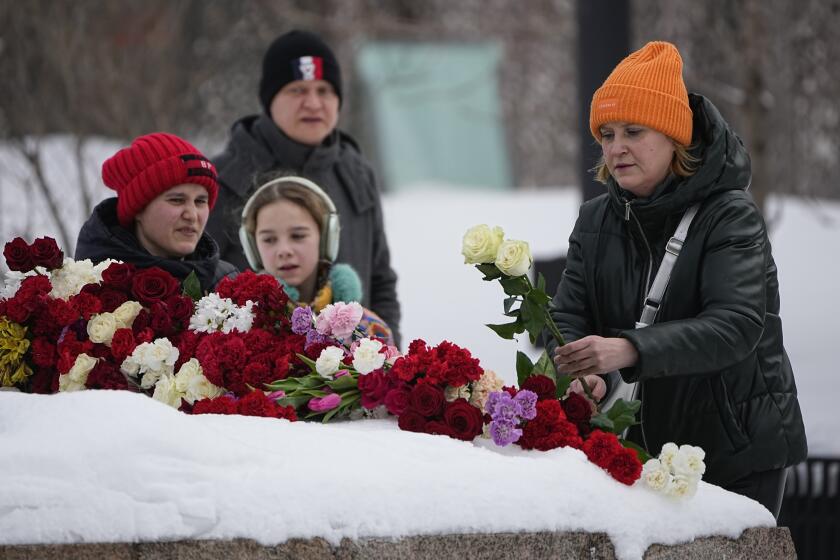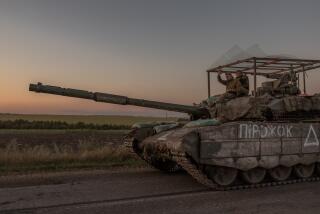Detecting Russian ‘carrots’ and ‘tea bags’: Ukraine decodes enemy chatter to save lives

- Share via
SEREBRYANSKY FOREST, Ukraine — As the radio crackles with enemy communications that are hard to decipher, one Russian command rings out clear: “Brew five Chinese tea bags on 38 orange.”
A Ukrainian soldier known on the battlefield as Mikhass, who has spent months listening to and analyzing such chatter, is able to quickly decode the gibberish. It means: Prepare five Beijing-made artillery shells and fire them on a specific Ukrainian position in the Serebryansky Forest, which forms the front line in the country’s restive northeast.
Hiding in the basement of an abandoned home seven miles away, Mikhass immediately warns the commander of a unit embedded in that part of the forest, giving him crucial minutes to get his men into trenches, saving their lives.
On the defensive and critically short of ammunition and soldiers after two years of war, Ukrainian forces are increasingly resorting to an age-old tactic — intelligence gleaned from radio intercepts — in a desperate effort to preserve their most vital resources.
The painstaking work is part of a larger effort to beef up and refine electronic warfare capabilities so that soldiers can be warned earlier of impending attacks, while having the battlefield intelligence needed to make their own strikes more deadly. To prevent enemy drone attacks, signal-jamming is also on the rise.
After months of near stalemate along the 621-mile front line, Ukraine expects fierce attacks in the year ahead from a Russian enemy determined to wear down its defenses to forge a breakthrough. Russian President Vladimir Putin has said there will be no peace until Russia achieves its goals, which include recapturing the entire Donbas region of eastern Ukraine, which it illegally annexed in 2022.
The commander elevated last week to lead Ukraine’s army, Gen. Oleksandr Syrskyi, has highlighted the importance of electronic warfare, and the country’s defense ministry has increased spending on the people and technology behind it.
Alexei Navalny, Russia’s best-known opposition figure, has died in a prison colony, authorities say. Biden and other Western leaders blame Putin.
Saving lives
Russia, which controls about one-fifth of Ukraine, has the advantage of a more developed domestic weapons industry, and it uses conscription and coercion to call up troops.
For Ukraine, ammunition shortages have forced brigades to use shells sparingly and only after locating precise targets. Difficulty in mobilizing troops means Ukrainian commanders must be extra protective of soldiers’ lives as they try to fend off ferocious Russian attacks.
It is within this context that better surveillance, eavesdropping and jamming have become more urgent.
Several miles south of where Mikhass is positioned, in the Donetsk region town of Konstantinivka, the 93rd Brigade’s Electronic Warfare unit is using jammers to stave off attack drones, the main driver of injuries for soldiers in the region.
The platoon commander is alert, staring at a laptop that shows signals picked up by small antennas planted near the front line. When a Russian Lancet attack drone approaches their area of operation, his screen lights up with activity.
A rights group says hundreds have been detained in Russia while paying tribute to opposition leader Alexei Navalny, who died at an Arctic prison colony.
The commander, known on the battlefield as Oleksandr, flips a switch to activate the jammer which interferes with the drone’s radar; it’s the equivalent of shining a bright light in someone’s eye to disorient them.
“It’s a must,” he says of their operation. “A lot of guys are dying because of drones.”
Radio operators like Mikhass work in shifts around the clock.
The antennas he relies on to pick up Russian radio signals are camouflaged, jutting out of trees in the forest near Kreminna, close to Russian positions. From a quiet basement command center nearby, Mikhass and other soldiers chain-smoke cigarettes and listen through headphones.
A new and sophisticated signal-finding antenna, which resembles a carousel, uses triangulation to locate where the radio waves are emanating from.
They cross-reference what they hear against images they gather from reconnaissance drones and use detailed maps of their enemy’s positions to slowly piece together what it all means.
They are part of a 50-person intelligence unit dubbed the Bunnies of Cherkess — the name inspired by the Chinese military strategist Sun Tzu, who advised warriors to feign weakness when one is strong.
“No one takes bunnies seriously, right?” said Cherkess, the commander of the eponymous unit.
Radio intercepts reveal that the Kremlin is determined to control the entire Serebryansky Forest, which divides Ukraine-controlled Lyman from Russian-occupied Kreminna. It’s part of an effort to reach Torske, a village in Donetsk that is west of Kreminna. From Torske, Russia will be closer to recapturing the nearby hub of Lyman, which would be a devastating setback for Ukraine and disrupt its ability to move supplies to the front.
‘Decoding orders’
Cherkess and his men, most of whom are volunteers who signed up for the infantry, understand the stakes couldn’t be higher, especially as signs grow that support from Western allies is less secure.
After listening to hours and hours of Russian communications each day, much of it related to troop rotations, artillery fire and drone reconnaissance, they gradually build an understanding — with help from specialized computer software — of what it all means.
“Cucumbers” are mortars, “carrots” are grenade launchers — and locations are conveyed in a numerical code with a corresponding color. It took the unit months to decode these Russian orders.
The arrival of new combat equipment and ammunition — and especially infantrymen — signals a fresh attack is imminent.
A soldier “is not interested in what kind of radar Russians have, he needs information on if there will be an attack tonight, and who will come, if they will have tanks, if they have armored vehicles or if it’s just infantry,” said Cherkess.
“And we have to understand how long we have to prepare. A week? Two weeks? A month?”
Advance word of enemy troops being rotated in and out is also useful to Ukrainian soldiers seeking to go on the offensive, he said. That is when they can exact maximum personnel losses.
The previous week, a Russian assault operation was carried out against a neighboring brigade. But the Ukrainian soldiers positioned there were prepared to greet them.
‘Staying ahead’
The importance of electronic surveillance can’t be underestimated, said Yaroslav Kalinin, chief executive of Infozahyst, a company under contract with Ukraine’s Defense Ministry.
Before the war, Infozahyst provided anti-wiretapping services for the offices of the president and prime minister. Once the war began, the company pivoted to help the army by manufacturing a versatile signal direction finding system, which is now in high demand.
The government recently doubled its contract with Infozahyst, according to Kalinin.
The buildup of surveillance capabilities is partly a recognition of the need to catch up to the Russians, who invested heavily in this technology long before they invaded Ukraine.
Kalinin believes that better and smaller devices that are easier to hide and move around will eventually give Ukraine an edge.
The Russians know they are being listened to and routinely try to deceive their enemy with bogus information. It is up to Mikhass and other radio operators to discern the signal from the noise.
“Their artillery helps us,” he explained. “They say where they will shoot, and then we check where the shells landed.”
“38 orange,” the location Mikhass recently heard about for an upcoming attack, is represented on a map by a small dot. And it is surrounded by hundreds of other dots that signify locations they have decoded.
“We need a lot of time to uncover these points,” he said.
And as Russia steps up the pressure, the clock is ticking.
More to Read
Sign up for Essential California
The most important California stories and recommendations in your inbox every morning.
You may occasionally receive promotional content from the Los Angeles Times.












